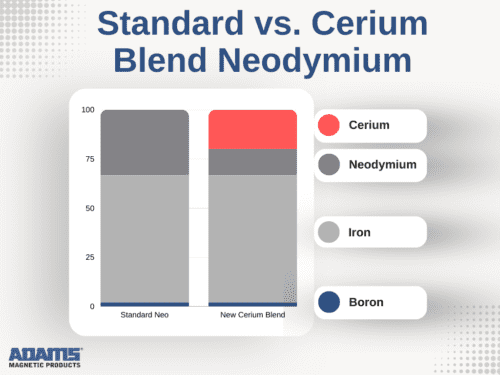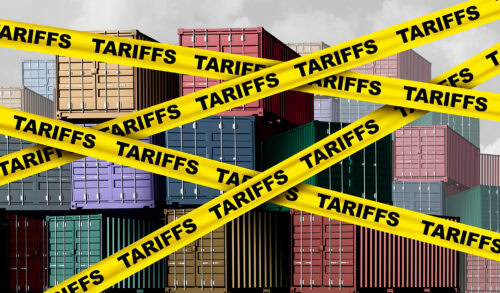Background
You may have heard there’s a new, lower-cost Neodymium Iron Boron magnet option. This new option replaces some of the Neodymium with Cerium, which helps to reduce the cost of the magnet.
A Bit of Neodymium History… Er, Science… Nope, History
 The popular Neodymium magnets are made up of a variety of materials, mostly Neodymium, Iron and Boron. They can also contain elements such as Dysprosium, Praseodymium, Cobalt, and a few other trace elements. The elements Neodymium, Dysprosium, Praseodymium are part of the group known as Rare Earths and are close to each other on the periodic table:
The popular Neodymium magnets are made up of a variety of materials, mostly Neodymium, Iron and Boron. They can also contain elements such as Dysprosium, Praseodymium, Cobalt, and a few other trace elements. The elements Neodymium, Dysprosium, Praseodymium are part of the group known as Rare Earths and are close to each other on the periodic table:
When mining for rare earths, the ore dug out of the ground contains many of the rare earth elements in various concentrations. A good mine is generally one where 5% of the ore contains rare earths. That fraction of rare earth is then subdivided, with some elements being more prevalent than others. Usually, Neodymium and other elements that are useful for magnets are only a tiny fraction of that original 5%. But Cerium is, by far, the most prevalent element.
While Cerium is a rare earth element, there haven’t been many applications that utilize it. Until now, the only noteworthy usage has been glass polishing and even that uses only a small fraction of the available Cerium.
So Why Now?
 Given its lack of usage, there’s now a surplus of Cerium. Magnet manufacturers began experimenting with this surplus and found that substituting Cerium for some of the Neodymium can produce an effective and lower-cost magnet. Although magnets containing Cerium are a bit weaker than traditional Neodymium magnets, they can be used in less demanding applications for a meaningful cost savings.
Given its lack of usage, there’s now a surplus of Cerium. Magnet manufacturers began experimenting with this surplus and found that substituting Cerium for some of the Neodymium can produce an effective and lower-cost magnet. Although magnets containing Cerium are a bit weaker than traditional Neodymium magnets, they can be used in less demanding applications for a meaningful cost savings.
Aside from the performance hit, magnets containing Cerium look and behave exactly like their non-Cerium counterparts. They can be easily plated with nickel or zinc and will weigh the same.
Pros and Cons
As of January 2023, Neodymium was selling for $73 per kilogram. At the same time, Cerium was selling for $2.2 per kilogram. Since Cerium is substituting for some, but not all, of the Neodymium magnet and factoring for processing costs, the result is a 5% to 10% price reduction.
However, since Cerium isn’t as effective as Neodymium at producing magnetism, magnets containing Cerium are generally only available in the lower grades, from Neo30 to Neo42.
At moment, the default is to offer non-Cerium magnets. However, if an application warrants it, we may suggest it as an option. Want to learn more about Cerium and its cost-saving potential? Contact our engineering team today!


